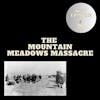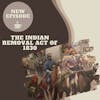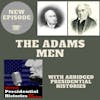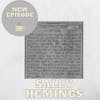The Mountain Meadows Massacre

As a group of settlers eagerly headed west in the throes of Manifest Destiny, they were being watched by a group who were convinced they posed a grave threat.
Known as the Mountain Meadows Massacre, the murder of over one hundred settlers led to the excommunication of members of the Mormon Church and remained shrouded in mystery for generations.
So what exactly happened? Tune in to find out.
SOURCES
Cep, Casey. “How Joseph Smith and the Early Mormons Challenged American Democracy.” The New Yorker. March 23, 2020. (LINK)
“Joseph Smith.” American Prophet Biography. PBS. (LINK)
King, Gilbert. “The Aftermath of Mountain Meadows.” Smithsonian Magazine. February 29, 2012. (LINK)
Rea, Ralph R. “The Mountain Meadows Massacre and Its Completion as a Historic Episode.” The Arkansas Historical Quarterly 16, no. 1 (1957): 28–45. (LINK)
Turley Jr., Richard E., Transcriber. “John D. Lee, Second Trial. John D. Lee Death Sentence.” 2016. (LINK)
The demands of justice will not be satisfied until the guilty leaders in planning or executing that crime are known and brought to the bar of justice and their cases investigated in the courts and passed upon by impartial juries. It gives me no pleasure to say anything in reference to this awful deed in which you were a willing participant. You and all those who plotted this deed of blood or willingly participated therein, are no doubt guilty of a great crime, and their unoffending victims, though their mouths are closed in this world, will meet and confront you all at the bar of almighty god, where the secrets of all hearts shall be made known. Jacob S. Boreman, Sentence of John D. Lee, October 10, 1876
Welcome to Civics and Coffee. My name is Alycia and I am a self-professed history nerd. Each week, I am going to chat about a topic on U.S history and give you both the highlights and occasionally break down some of the complexities in history; and share stories you may not remember learning in high school. All in the time it takes to enjoy a cup of coffee.
INTRO MUSIC
Hey everyone, welcome back.
Nestled along a quiet canyon in the bucolic Utah landscape lies the site of a terrible tragedy. In 1857, a group of men, women, and children making their way west toward California, set up a temporary camp in Mountain Meadows. The valley was a perfect grazing area for cattle with enough space for the caravan of nearly 200 to set up temporary shelter. However, unbeknownst to the traveling party, they were wandering into dangerous territory. And it cost many of them their lives.
A few months back I received a request from longtime listener of the show, Chance, to cover the horrific events that led to the death of nearly 200 people. So this week, I am covering the Mountain Meadows Massacre.
What happened? Who was involved? And why did it take nearly twenty years for someone to be brought to justice?
Grab your cup of coffee, peeps. Let’s do this.
To understand how such a horrific act of violence could have been carried out, it is important to understand the series of events that contributed to a sense of distrust and, if I may be so bold, paranoia.
In 1830, Joseph Smith established the Church of Latter Day Saints. Born in Vermont, Smith was in search of a religious home, unsure of what church to join. Seeking guidance in the backdrop of the Second Great Awakening, Smith apparently decided to seek God’s advice and waded into a nearby forest. His prayers were answered as two figures appeared before him, God and Jesus Christ, who advised against joining any existing church. Smith was then later visited by an angel who shared the location of a series of divine plates sharing the story of Jesus’ journey from Jerusalem to the United States. Smith traveled to this secret location, discovering the plates and transcribing them, the text of which became The Book of Mormon, the foundational text of the religion.
Smith and his new religion attracted a number of followers, but the group quickly found themselves on the wrong side of the law, and Smith was arrested several times for things like being a quote “disorderly person” end quote. Tensions escalated further as antagonists, who were suspicious of the religious leader, harassed Smith and his followers including vandalizing the homes of followers. The sustained harassment pushed the group to move further outside of normal society and into the frontier, first setting up home in Ohio before moving to Missouri.
Unfortunately, the move failed to diminish the animosity aimed at Smith, who was executed in 1844. His successor, Brigham Young, thought the best solution was to move beyond the reach of the United States government, prompting his followers to pack up once more and head toward what would eventually become the Utah territory, which was then part of Mexico. Of course, with the signing of the treaty of Guadlupe Hidalgo, the previously lawless territory came under the jurisdiction of the United States and several followers began to worry about future interventions by the government.
Given this widespread suspicion, there were some who became concerned that with the treaty transferring the territory to the United States, would lead to the federal government charging in, further persecuting members. This feeling remained, despite the fact that then President Millard Fillmore appointed Young as the territorial governor, a decision that did not go over well with those who were not followers of the Mormon faith. Residents in the Utah territory were leary of Young and his followers, concerned the church was supportive of polygamy - which of course they were. This unease only continued to fray at the precarious relationships within the community.
And here is where John Doyle Lee enters the story. Born in the Illinois territory in 1812, Lee and his wife joined the church in either 1837 or 1838. A member of the church’s secret order known as the Danites, Lee was responsible for protecting and defending his fellow church members. Lee took this duty seriously, getting into a ruckus with residents in Missouri that turned violent in 1838. Lee was living in Kentucky when Smith was lynched in 1884, but heard of Young’s proposal to move west and decided to join. Lee seemed to thrive in his home, successfully building a base of operations ane eventually became a United States Indian Agent in 1856 where he used his skills as a farmer to quote un quote aid indigenous americans in establishing their own land for cultivation.
However, the community could not seem to escape the attention of the government and antagonists and when another Mormon, Parley Pratt, was murdered in 1857, Young and fellow LDS members were convinced it was the result of religious persecution, ignoring the events leading to Pratt’s death. While Pratt’s faith played a hand in his death, he was not singled out as a Mormon. Instead, Pratt was murdered by the legally recognized husband of one of his many wives - likely more a crime of passion that religious bigotry. Regardless, Young instructed his followers to close ranks and the group began stockpiling food and issuing warnings to anyone coming near the area to steer clear of their territory or face the wrath of the Danites.
Young, as territorial governor, also declared martial law, making it illegal for anyone to travel through the area without a permit. But, given that this was the middle of the nineteenth century, his declaration of martial law was not exactly common knowledge and settlers were already making their way west, on a path that would lead them straight through the Utah territory and put them face to face with an increasingly paranoid group of people.
Traveling from Arkansas to California, the Baker-Fancher party consisted of nearly 200 people traveling in 40 wagons. The caravan included a thousand cattle and hundreds of horses and a significant amount of wealth, with an estimated value of $70,000. Despite their massive numbers, the party still needed to restock their supplies along the journey, but Young had forbidden followers from providing any rations to outsiders. Likely unaware of Young’s requirement to procure a permit, the group arrived in Great Salt Lake City in early August before taking the southern trail toward Cedar City. What the caravan did not know was that as they arrived in Cedar City, they were being monitored. William Dame, Isaac Haight, Philip Klingonsmith, and John Higbee - referred to as saints - were tracking the party’s movements and, in a bit of frenzy over the quote unquote persecution of Parley Pratt, started to formulate a plan to get rid of what they saw as intruders.
As the party continued along their journey, the four Mormon Saints sent for John Lee, hoping he’d provide assistance in planning an attack. The men did not want to go after the caravan themselves, worried about potential repercussions from the federal government, and thus decided to try to have indigenous Americans do the dirty work for them. As Lee was the U.S. Indian Agent, he was seen as the perfect person to push for an attack, as he had built solid relationships with the surrounding tribes. Lee warned local indigenous groups that the caravan of men, women, and children posed a serious threat and were headed toward their land. Lee then ordered the (PIE OOTS) Paiutes to murder the group, going so far as to provide weapons. Lee’s plan took some convincing as the Paiutes did not have a habit of performing large scale raids. However, Lee and his colleagues managed to convince the group that the caravan was an enemy and guaranteed the tribe a bountiful plunder if they aided in the attack.
Meanwhile, the Baker-Francher party remained completely oblivious to the plot and continued along their journey, setting up camp at Mountain Meadows on September 7, 1857. It would be the last time the travelers would have peace as the group of Paiutes and Mormons, also disguised as fellow tribesmen to avoid detection, attacked the camp. The party proved more resilient than expected and successfully defended themselves for five days. The Mormons, already paranoid about an invasion from the federal government, because to worry that the Baker-Francher party knew they were part of the attack and that, if they survived, would quickly report the Mormons which would expedite an attack by the U.S Army. This fear prompted militia commander William Dane to order that no witness be left alive.
Entering the camp under a white flag of truce, the Mormon attackers offered the caravan safe passage to Cedar City if they agreed to leave their livestock with the Paiutes. The agreement was they would escort the camp in three separate groups, men first, followed by the women, and finally the children. Up against a rock and a hard place, the travelers decided to agree to the terms and the men packed up their materials and prepared to head out with their guides. As soon as they were separated, the Mormon militia slaughtered the group, leaving only 17 children alive who were later taken in by other Mormon families. It is estimated that 120 people lost their lives as a result with the militia hoping to escape blame by putting the attacks on their indigenous helpers.
In piecing together events, it remains a little unclear just how much Mormon leader Bringham Young knew and to what extent he authorized or otherwise supported the attack. Initially, the story was that Young did not support the invasion, issuing a letter to militia leaders to avoid engaging in any violence that did not make it to them in time. When asked about the course of events, John Lee blamed the Paiutes as planned. This became the official position of the LDS church for generations and did not shift until the 2000s.
But this version of events began to shift upon Lee’s conviction in 1877. The only man to be arrested for the massacre, John Lee later wrote a memoir claiming that Young was behind the attack, something Young denied. Lee also tried to paint himself as a martyr, claiming he tried to do everything he could to aid the traveling party.
When the U.S. army did finally arrive in 1858, they went to work examining the massacre, trying to uncover the course of events and assuming custody of the 17 children left behind. In their investigation, the army pointed to Mormon militia men as the cause for the masacre, leading Young to excommunicate both Lee and Isaac Haight for their roles. However, it would take nearly twenty years for anyone to be brought to justice. But why?
There are a number of contributing factors for the delay, the first of which being the location of the territory. Sitting along the western frontier, it wasn’t exactly close to the federal government and so any troop movement or other oversight attempts were delayed. Additionally, and likely the largest contributing factor, were the increasing tensions between the states in the run-up to the Civil War. While the United States was interested in developing the Utah territory, the ongoing issues over slavery and the SEH-SESH-UN SUH SESH UN secession of southern states took center stage. Then, of course, you have the war which took the government’s full attention.
But, despite the delays, John Lee was eventually arrested and tried the first time in 1875, where the trial ended in a hung jury. Committed to securing justice, Lee was charged again in 1876 and this time his trial ended in a conviction and he was sentenced to death, a portion of which I read at the top of the episode. His method of execution? A firing squad.
It was while awaiting his conviction that Lee set about writing his memoir. Titled Life and Confessions of John D. Lee, the now convicted murderer, tried to retell the story of the massacre from his perspective. In discussing the attack, Lee wrote quote: “I believe that most of those who were connected with the massacre, and took part in the lamentable transaction that has blackened the character of all who were raiders or abettors in the same, were acting under the impression that they were performing a religious duty,” end quote.
Lee’s execution date was set for March 28, 1877 - nearly twenty years after the massacre. In an odd bit of poetic justice, the site of his execution was the same location of the mass murder - Mountain Meadows. His death prompted hundreds of onlookers, with some 300 people supposedly in attendance. With a coffin set behind him, Lee’s last request was that the five men tasked with pulling the trigger aim for his chest so as to leave his face undamaged.
In an act of questionable morality, LDS membership maintained they played no willing part in the massacre for generations, letting the Paiute members shoulder the blame for the attack. And, despite Lee’s excommunication over his part in the murder in 1870, he was quietly reinstated by the church in 1961. It wasn’t until 150 years later, in 2007, that the LDS Church finally fessed up to their role in the massacre, issuing a formal apology to the indigenous Americans who received the lion’s share of the blame, saying in part quote: “it is believed they would not have participated without the direction and stimulus provided by local church leaders and members” end quote.
An act of horrific violence perpetrated over fear of religious persecution, the Mountain Meadows Massacre was a dark and traumatic moment in our past and was made worse by continuing to deflect blame onto others.
I want to thank Chance again for suggesting I dive into this topic. Whether they be good, bad, or ugly, listener requests are always some of my favorite things to dive into as I always learn something new. Also, Chance is a fellow podcaster who runs the great Strive, Seek, Find. Chance covers a myriad of topics and his short, to the point episodes always make for a fun listen. He has been on a bit of a break lately, but I hope he comes back soon.
If you ever want me to cover a topic, just let me know. You can find me through most of the socials, though I am most active on instagram and trying to build up my network over on Bluesky. Or you could head over to the website www dot civics and coffee dot com.
The website is also where you can see transcripts and learn about ways you can support the pod.
And lastly, before I sign off this week, I hope you all had a wonderful holiday weekend. For me, I am thankful for all of you out there. Your support and feedback have meant so much to me over these last few years and I am so honored you queue up this little show each and every week.
Thanks, peeps. I’ll see you next week.
Thanks for tuning and I hope you enjoyed this episode of Civics & Coffee. If you want to hear more small snippets from american history, be sure to subscribe wherever you get your podcasts. Thanks for listening and I look forward to our next cup of coffee together.
OUTRO MUSIC
Listener Favorites
Not sure where to begin? Take a listen to some fan favorites.

























